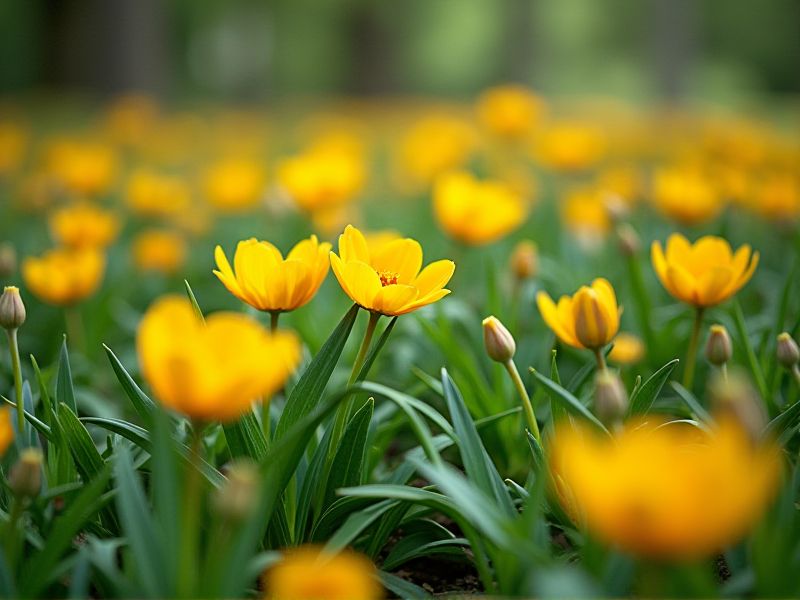
Groundcover plants that flower serve both aesthetic and functional purposes in landscaping. Varieties such as creeping thyme and Phlox subulata create vibrant carpets of color while suppressing weeds and stabilizing soil. For shaded areas, consider vinca minor or ajuga reptans, which provide blooms alongside glossy foliage. Additionally, flowering groundcovers attract pollinators, enhancing biodiversity in your garden ecosystem. Incorporating these plants can transform your outdoor space into a thriving, colorful haven.
List of some Groundcover plants that flower
- Creeping Thyme (Thymus serpyllum)
- Creeping Phlox (Phlox stolonifera)
- Bugleweed (Ajuga reptans)
- Deadnettle (Lamium maculatum)
- Snow-in-Summer (Cerastium tomentosum)
- Yellow Archangel (Lamiastrum galeobdolon)
- Candytuft (Iberis sempervirens)
- Ice Plant (Delosperma cooperi)
- Lilyturf (Liriope muscari)
- Woolly Yarrow (Achillea tomentosa)
Important things about Groundcover plants that flower
Types Of Flowering Groundcover Plants
Flowering groundcover plants are an excellent choice for gardeners seeking to enhance their landscapes with vibrant colors and textures. Varieties such as Creeping Thyme, which boasts tiny purple blooms, and Sedum, known for its striking yellow flowers, are both low-maintenance options that provide visual interest. Other popular choices include Ajuga, or Bugleweed, featuring deep blue flowers, and the perennial Creeping Phlox, adored for its lush clusters of pink and white blossoms. Incorporating these flowering groundcovers into your garden not only beautifies the space but also improves soil health and provides habitat for pollinators.
Growing Conditions And Requirements
Groundcover plants that flower thrive in a variety of growing conditions, making them a versatile choice for gardeners. Ideally, these plants prefer well-draining soil enriched with organic matter to promote healthy growth and vibrant blooms. Many flowering groundcovers flourish in full sun but can also adapt to partial shade, allowing you to enhance your landscape in diverse environments. To ensure optimal flowering, regular watering and occasional fertilization are essential, particularly in dry periods or poor soil conditions, providing you with a lush carpet of color throughout the growing season.
Flowering Seasons And Duration
Groundcover plants that flower can transform your landscape with vibrant blooms and foliage. For instance, creeping thyme typically flowers from late spring to early summer, showcasing its small yet aromatic pink or purple flowers. Similarly, creeping phlox bursts with color during early spring, creating a carpet of pink, blue, or white blooms that can last for several weeks. Consider your region's climate and soil conditions to select the best flowering groundcovers that will thrive and beautify your garden throughout the seasons.
Pollinator Attraction
Groundcover plants that flower, such as creeping thyme and sweet woodruff, play a vital role in attracting pollinators, including bees, butterflies, and beneficial insects. These flowering plants provide abundant nectar and pollen, essential for the nutrition of pollinators, thus enhancing biodiversity in your garden. By incorporating varieties like dichondra and moss phlox, you create a vibrant habitat that supports not only the pollinators but also enhances the visual appeal of your landscape. Utilizing groundcovers can significantly reduce the need for chemical pesticides, fostering a healthier ecosystem while promoting essential ecological processes.
Maintenance And Care
Groundcover plants that flower provide both aesthetic appeal and functional benefits for your garden. To ensure vibrant blooms and healthy growth, regular maintenance is essential, including appropriate watering, mulching, and pruning. Selecting native flowering groundcovers, such as creeping thyme or phlox, can support local pollinators and build a resilient ecosystem. For optimal results, conduct soil tests to adjust pH and nutrient levels, ensuring your flowering groundcover thrives in its environment.
Soil And Drainage Preferences
Groundcover plants that flower thrive best in well-drained soil, which prevents root rot and promotes healthy growth. Varieties such as creeping thyme and ajuga prefer slightly acidic to neutral pH levels, making them ideal for diverse garden settings. These flowering groundcovers not only enhance visual appeal but also provide ecological benefits, attracting pollinators and enriching soil through their organic matter. When selecting your flowering groundcover, consider the specific drainage requirements to ensure optimal performance and vibrant blooms throughout the growing season.
Sunlight And Shade Tolerance
Groundcover plants that flower are ideal for enhancing both sunny and shaded areas in your garden. For sunny spots, consider varieties like creeping phlox or clover, which produce vibrant blooms and require full sun exposure. In shaded regions, options such as ajuga or creeping Jenny thrive while offering attractive flowers, adding color to low-light landscapes. Selecting the right flowering groundcovers can transform your space, providing a lush, visually appealing ground layer that supports both aesthetics and local biodiversity.
Landscape Applications And Design
Groundcover plants that flower provide not only aesthetic beauty but also functional benefits in landscape design. Varieties such as creeping phlox and ajuga offer vibrant blooms that attract pollinators while suppressing weeds, making them ideal for low-maintenance gardens. When planning your landscape, consider incorporating flowering groundcovers like sedum or daylily, which thrive in various soil types and sunlight exposures. These plants enhance visual interest, enrich biodiversity, and contribute to soil health, creating a sustainable and captivating outdoor space.
Disease And Pest Resistance
Groundcover plants that flower not only enhance the aesthetic appeal of your landscape but also provide excellent disease and pest resistance. Varieties like Creeping Thyme and Ajuga are known for their hardiness, thriving in diverse conditions while repelling common pests. Flowering groundcovers like Vinca Minor and Sedum are particularly efficient in preventing soil erosion and suppressing weeds, making them practical choices for gardeners. By selecting these resilient species, you can create a vibrant and low-maintenance garden that supports local ecosystems while minimizing the need for chemical treatments.
Invasive Species Concerns
Groundcover plants that flower, such as Creeping Phlox or Sweet Woodruff, can enhance garden aesthetics while providing crucial ecological benefits. However, some flowering groundcovers can also become invasive, outcompeting native plant species and disrupting local ecosystems. It's important to choose non-invasive varieties, like Creeping Thyme or Ajuga, to maintain biodiversity and support local wildlife. When selecting groundcover plants for your landscape, consider their growth habits and potential impact on surrounding flora.
